The obvious question that arises is: “What's is the point..or the "sense"” to build a micro dobson like this?
The sense is just that… That such a small instrument and light and without a tripod, allows you to observe when walking up hill or mountains, or on other occasions, that You can't take or "carry around" anything bulky as a classic telescope, that for any smallest it can be...., it need a tripod. And the alternative would only be to NOT be able to observe for anything.
Given the above: The little case (luggage) measures 230 x 300 mm ( as a sheet of paper in size ISO 216 – A4 ) briefcase thickness 145 mm, weight 3250 grams for the telescope complete with everything necessary for observation.
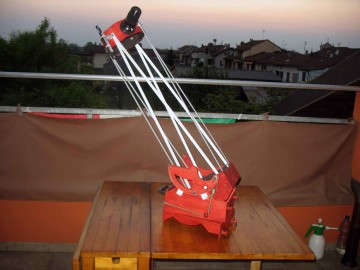
The micro Dobsonian ready (for visibility only missing the lattice screen, which it makes visible the dynamic counterbalance to the luggage elastics).
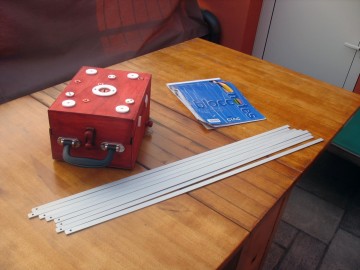
The 8 lattice pieces, and the briefcase compared with the size of a notebook A4, but containing everything you need to observe, including zoom eyepiece 8-24mm; elastic dynamic counterweight; Black tarp light shield for the lattice frame, and red-dot Finder, or green laser.
One day I happened to read an advertisement relating to sale for only few euro, a primary mirror (diameter 130 mm) and secondary (diameter 28 mm) complete with cross support ("spyder vane"), from a Newton telescope TAL 130F7.
The long focal ratio F7, however, immediately made me foresee two possible problems to solve for a little dobson.
The first possible problem was the balance of a trellis so long compared to the light weight of the small primary mirror in its cell.
The second problem could be the possible exit from the center of gravity with lateral tilting of the telescope when aiming for a very low object, the first part of the briefcase constituting the rocker box (which is rectangular), was to be rotated with its long side parallel to the short side of the second part of the same rectangular case constituting the Ground board.
So to solve the problem of balancing the long truss, provided for the installation of a dynamic counterweight carried out with a car boot strap, hooked to the lower part of the side bearings.
In this way, the traction force of the elastic increases with the increase of the cosine of the angle of inclination of the telescope, that is, precisely in the same way in which the need for counterweight contrast force increases. (see tutorial https://www.grattavetro.it/ri-bilanciamento-dinamico-con-elastici-di-telescopio-dobson-light/)
While to avoid the lateral overturning probably possible when the upper part of the long telescope was turned to point a low object on the horizon, orthogonal to the base ground board which is on the ground, expected to manufacture a small counterweight made with a 15x7cm cloth bag closed with velcro, filled with lead shot (the quantity of which in the testing phase turned out to be 800 grams) to insert, of dish, on the inside bottom of the rocker box so as not to disturb the inclination of the primary case.
Made these two compromise considerations with the small compact size desired for the telescope, the thought that it was worth doing a little "do it Yourself" exercise to create an ultra light and ultra portable mini telescope as only a dobson can be, to satisfy my walks “backpacker” across mountain huts accessible only by walk, without having to forgo the pleasure of observing evenings under really dark skyes….
(This is because a backpack, where You have yet “every time clothings”, it is the bare minimum to your needs of spartan autonomous daily life in a difficult and unpredictable environment such as the mountains, you can not put a telescope EVEN. Unless…. It is not a mini Dobsonian).
This first thought was already strengthened by he second ... that the telescope be achieved could be a suitably reduced scale version, but identical constructively to my other travel dobsonian telescope 250F5 Briefcase, in "cabin" dimensions (that means is transportable as hand airline luggage ), that I had previously built after having diligently designed with CAD.
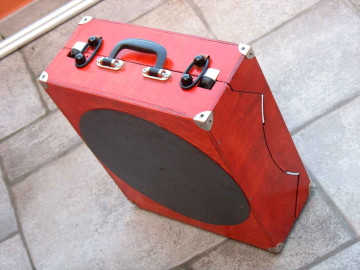
The precursor to Dob 250F5 case with measures “"cabin" model for carry-on plane.”, from which the CAD drawing was scaled to achieve the micro telescope in this article.
In fact, it is known that one of the advantages of creating a project using CAD software, is preciselyl that it permit with, a few simple mouse clicks, change you the overall scale of a chosen factor, and of being well in hand, printable, the drafts of new parts to be achieved with the real sizes, at most, to be rounded to the nearest integer value..
Purchased mirrors, 250F5 design I scaled by a factor equal to the ratio of the diameter of the two primary mirrors, 130/250 = 0.52 , excluding the thikness of the mini Briefcase, as, for convenience and labor savings (and no longer having to contain the extent of the total height of the new case within the complex of measures that characterize the size suitcases "cabin" ), I decided to make a dimension for that height so that you can comfortably hold the reuse of the original TAL secondary mirror support.
(NOTE: The CAD drawing of this telescope, unlisted but realized in scale 1:1, can be requested free of charge with a comment on this article, or by writing an e-mail to the Grattavetro editor, indicating e-mail address).
The choice of the thickness of the plywood came in light of the fact that the plywood used for the realization of the 250F5 was in three different thicknesses :10mm for the (side bearings); 8mm for the whole base frame, and 6mm for the structure of the secondary cage; but considering the inherent strength of any multilayer (although of simple poplar wood, this material is a rugged plywood "composite"), I decided to make all the mini dobson with plywood (with the exception of side-bearings made of 10 mm thick) in a single 5mm thick, assembled by gluing with white glue with the help of some long thin nail like glue Guide.
Glued plywood structure even without use a two-component epoxy glue, becomes a whole one with great strength and incredible stability, much higher than the modest stresses which will meet the telescope in its operational life.
Other constructive criteria were that the cell primary mirror had to be thin, simple, functional, rugged, and with collimability from the top.
Five characteristics that resulted in my "brain storming" to draft a simple cell without floating triangular support, made of thick sheet steel 2mm, a planform like "six-pointed star", cropped with alternative electric hacksaw use manual, and with three vertex at 120° of these "rays" from this star, intended to make mirror collimation ; and the other 3 "rays" to be bent upward to the containment of the primary mirror.
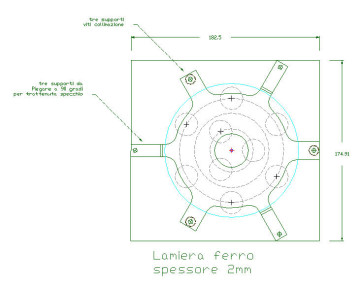
The plate in 2mm thick steel from which the simple support of the primary cell has been cropped. The three long lobes, bent to 90°at the double line,to border on the primary; While the others three short lobes are the location of the three screws and springs for the collimation.
To the lattice the choice fell on 8 20x2mm strips of aluminum (weight 400g) each 760mm long, also if originally I thought to use (segments of 2 meter carpenter’s rule) that I haven't realized.
These aluminium plates platform making up the frame are placed in the perimeter of the case of the primary mirror, in as many specific inclined receptacles formed by clips from aluminum profile with U-section, 20mm long internally (as the lattice Strips).
This mounting requires no fastening in the lower part of the pylon (otherwise incompatible with the small dimensions of the object), since the slipping upwards is in fact prevented from mutual inclination of each pair of tie rods, that the sole converging fastening bolt located on the secondary cash, makes the whole trellis simple and fixed.
The focuser 1 "¼ is simple helical type, and I did realize from a Turner out from a piece of round black nylon rod, on my design. Its weight is only 40 grams and its helical movement occurs on thread pitch 3mm "two principles" (English: “multi-start threads; Spanish: Thread with multiple inputs; French: Nets with several inputs).
The which in other words means that on it two parallel spirals of 3 + 3mm were obtained, that make every lap of the focuser it remains of (3+3=) 6mm.
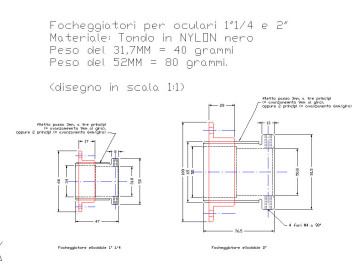
The construction design for the turning of the super light helical focuser made from very cheap round black nylon, with on-pitch threading screw movement 3 mm a “dual principle” in order to obtain an advancement of 6 mm each turn.
I believe that every image in this Gallery collection, makes the idea better than any word
Although the aesthetic leaves a little to be desired (painting is incomplete and limited to biting red. no glossy finish epoxy), the practicality of use and the performance of such a telescope are satisfactory, Despite being extremely Spartan telescope.
With it I use preferably one zoom eyepiece 8×24, with red dot finder, or the less discreet green laser.
A slight handicap for air transport as a walk-on baggage, is this micro telescope Dobson, and both larger homolog 250F5 "cabin", is that in every airport check-in, you see the backpack that contains it exit the x-ray control and divert towards a "siding", where you will have to explain to controllers suspicious and intrigued, that this disc contained inside the Briefcase is not a bomb, but a parabolic mirror.
It should be aiding the rapid dispatch to these control operaions, to show summarily the use of this telescope also with the aid of images, to the controllers... that from their pleased astonishment You understand that obviously does not happen often to meet them "crazy stargazers" running around the world with hands luggages of this strange genre.
IN CONCLUSION: With a dispassionate judgment of elderly “stargazer”, I say that as a telescope is certainly "better than nothing"…. And happen to say so when you are accustomed to other wel different and very exciting openings!!
But his positive side is that it does well its minimal task in an area where the alternative (going to the mountains on foot) is not looking for nothing at all but the naked eye; And where there is no convenient alternative, even with the smallest refractors, works , like my "ottantino" Konus Vista 80F5, requires to add in your back-pack a minimum of certainly unstable tripod, with footprint, weight and annoying vibrations well exceeding those provided by this slight …. all in one "Biscuit Box" ![]() .
.
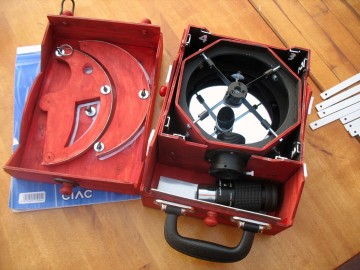
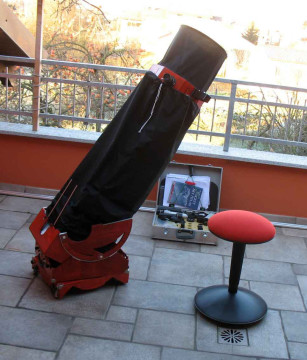
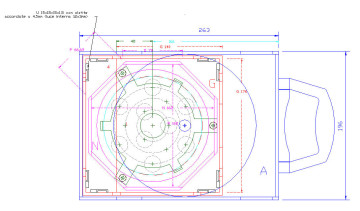
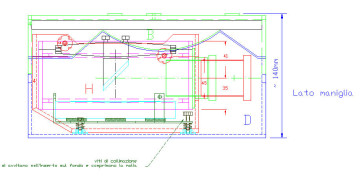












GAWH1981
Giulio TiberinI